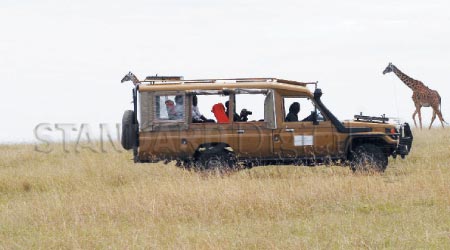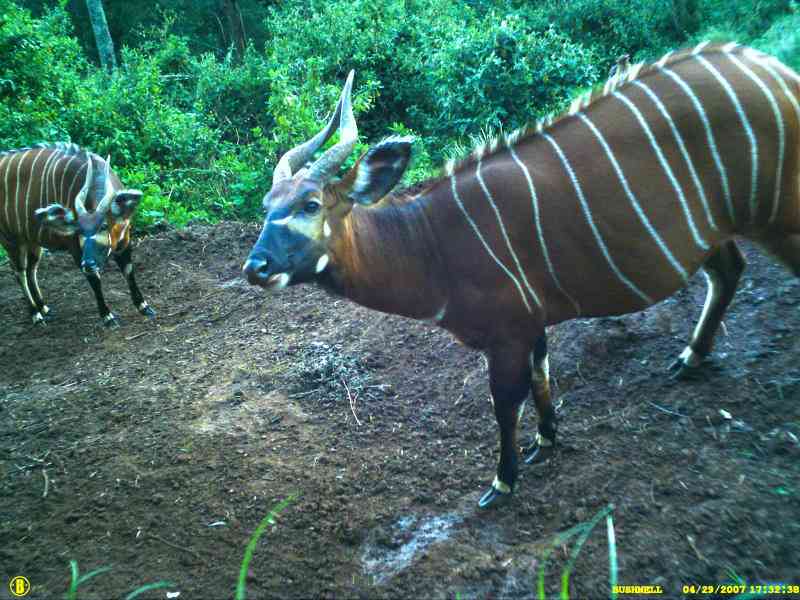 |
|
Tourists enjoy a game drive. (Photo:Peter Muiruri/Standard) |
By Thorn Mulli
The number of animals one sees in a game drive usually determines the extent of the drive’s success. Spotting the big five or witnessing a spectacle like a carnivore chase and kill, or the birth of a baby giraffe makes the drive worth the experience.
Here are some tips that will help you maximise your wildlife viewing successes.
Pick the right season
The dry season is the most optimal season to watch animals. The water holes attract not only a large concentration but a wide variety of animals as well. This makes it easy for you to view wildlife as you simply drive by, or watch from the small shelters many game parks put up overlooking the water holes.
The dry season also means the vegetation has thinned out unlike during the wet season where one cannot literally see anything beyond the road because the grass is too tall. You would be amazed at how well camouflaged, even a large group of elephants can be when the vegetation is nice and lush after some good rain.
In East Africa the dry seasons are from January through March and July through October.
If interested in the annual migration of wildebeest and zebra, then need to time your trip with the weather in mind. In the Maasai Mara, they usually arrive between August and September, stay through October, and head back over to the Serengeti in Tanzania between December and January.
Dress the part
It is recommended that one wears earth tone colour clothes when on a game drive. One, however, does not have to purchase a new safari wardrobe. Avoid the colours of black and dark blue known to attract biting and disease-carrying tsetse flies. Also avoid white-coloured clothing, as they will turn streaky brown from the ever-present dust.
You can invest in a 21-pocket safari vest (sometimes called a photographer’s vest) whose multiple pockets organise what is carried leaving the hands free for the binoculars or camera. Natural fibre clothing, like breathable cotton, is most comfortable in the wild. Wear long sleeve shirts and long pants from dusk to dawn when biting insects appear.
In the higher altitudes, a sweatshirt or windbreaker is good for the chilly early mornings and cool evenings, though the daytime temperatures can be quite warm. Surprisingly, a bandana is genuinely useful against the dust that permeates the hair and skin on game drives.
The bandana covers the nose, mouth, throat, ears and lower half of the face. It effectively functions as a dust mask, but covers a much larger area. Comfort, not style should be your mantra. Wide-brimmed hats, sunglasses, lip balm, sunscreen lotion help protect one from the brutal sun.
Pick the right time of day
The best time to spot game is at dawn and dusk. At midday, the sun is hot and most animals prefer to siesta under the shade of a tree, usually far from the roads you’re driving on.
Stay informed. Subscribe to our newsletter
Go with a guide
Guides will often be in radio contact with each other, so if one spots a great lion kill, they can let your party know so you get to see it too. A guide is also useful in identifying species. Even if you carry a nice guidebook, it can be difficult to tell the difference between a female sable and an impala in full flight.
Know where to look
Look up in the trees if you want to spot a leopard, look in rivers if you want to see crocodiles (especially in patches of reeds) and watch out for steaming dung heaps to give you a good indication of how close you might be to an elephant. Take a wildlife distribution map with you so you know what you are looking for at various points in the park.
Appropriate accessories
Game parks are often large tracts of land and the animals are camouflaged, so bring a pair of binoculars. If you’re into photography, invest in a high-quality digital camera.
Be patient and hope for some luck
Please realise that you are going to see a lot of the same types of animals like giraffe, zebra, wildebeest, and gazelle more commonly than you will leopards, lions, hyenas, or cheetah but patience often yields some luck. You are likely to see some cool things, but nothing is guaranteed — this is wild after all!
 The Standard Group Plc is a
multi-media organization with investments in media platforms spanning newspaper
print operations, television, radio broadcasting, digital and online services. The
Standard Group is recognized as a leading multi-media house in Kenya with a key
influence in matters of national and international interest.
The Standard Group Plc is a
multi-media organization with investments in media platforms spanning newspaper
print operations, television, radio broadcasting, digital and online services. The
Standard Group is recognized as a leading multi-media house in Kenya with a key
influence in matters of national and international interest.
 The Standard Group Plc is a
multi-media organization with investments in media platforms spanning newspaper
print operations, television, radio broadcasting, digital and online services. The
Standard Group is recognized as a leading multi-media house in Kenya with a key
influence in matters of national and international interest.
The Standard Group Plc is a
multi-media organization with investments in media platforms spanning newspaper
print operations, television, radio broadcasting, digital and online services. The
Standard Group is recognized as a leading multi-media house in Kenya with a key
influence in matters of national and international interest.









